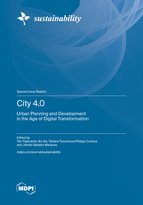City 4.0: Urban Planning and Development in the Age of Digital Transformation
A special issue of Sustainability (ISSN 2071-1050). This special issue belongs to the section "Sustainable Urban and Rural Development".
Deadline for manuscript submissions: closed (30 September 2023) | Viewed by 33579
Special Issue Editors
Interests: smart technologies, communities, cities and urbanism; knowledge-based development of cities and innovation districts; sustainable and resilient cities; communities and urban ecosystems
Special Issues, Collections and Topics in MDPI journals
Interests: construction management; green buildings; sustainable development; built environment for ageing in place; sustainable retirement villages
Interests: resilient and sustainable cities; smart cities; urban planning; environmental law; climate change
Interests: cities; sustainable cities; data; entrepreneurship; commons; innovation ecosystems; knowledge-based economic development; city as a platform; living labs
Special Issue Information
Dear Colleagues,
The combination of the computer and distributed networks during the last several decades has led to two ‘Digital Revolutions’ that today allow anyone to create, disseminate, and access any information anywhere, any time and from any smart device. The birth of the ‘Digital Age’ is a result of a research ecosystem that was nurtured by government spending and military–industry–academia collaboration, along with the alliance of community organisers, communal-minded hippies, do-it-yourself hobbyists and homebrew hackers. Strictly speaking, this collaborative creativity that defines the digital age included collaboration between humans and machines. This interaction has changed the way some services are delivered. For instance, today, the world’s largest taxi company, Uber, owns no vehicles; the world’s most popular media owner, Facebook, creates no content; the world’s most valuable retailer, Alibaba, has no inventory; and the world’s largest accommodation provider, Airbnb, owns no real estate. In addition, owing to rapid developments in the digital age, technology is widely seen as an effective apparatus to help us solve some of the most challenging problems the world is facing today, particularly when the human element is strongly considered alongside technological capabilities (Yigitcanlar, 2016).
Today, unexceptionally, all parts of the world are confronted with various environmental, social, health and economic crises—e.g., life-threatening natural disasters, the loss of biodiversity, the destruction of natural ecosystems, regional disparities, socio-economic inequity, pandemics and digital and knowledge divides that are mainly caused by rapid population increase and expansion of resource consumption, combined with industrialisation, urbanisation, mobilisation, agricultural intensification, and excessive consumption-driven lifestyles. Rapid advancement in digital technologies give us the hope that the impacts of global-scale environmental, social and economic crises can be eased with the help of appropriate technology (Yigitcanlar, 2016).
Furthermore, in recent years, the expansion of the Fouth Industrial Revolution, or Industry 4.0, to cities has disrupted the way cities are planned and developed and has generated a new city conceptualisation—i.e., City 4.0 (Chauhan et al., 2021). This new city blueprint, City 4.0, aims to leverage the power of engaged and connected citizens and digital technology and data to ensure and enhance the quality of urban life, productivity and sustainable development (D’Amico et al., 2020).
This Special Issue invites papers reviewing, empirically exploring or theoretically expanding the City 4.0 concept and practice from the angle or urban planning and development (or in simple terms, urban planning and development in the age of Industry 4.0). We welcome manuscripts that contribute to conceptualisation, policy, strategy, legislation, process or practice or at their interfaces, in the form of empirical research articles, systematic literature reviews, case reports, viewpoints, perspectives and short communication pieces.
Topics:
The topics include but not limited to the following.
- Artificial intelligence technologies and urban planning and development
- Big data analytics and urban planning and development
- Blockchain technology and urban planning and development
- Cloud, fog, edge and distributed computing and urban planning and development
- Data-driven and evidence-based governance and urban planning and development
- Digital technologies and infrastructures and urban planning and development
- Digital transformation in cities and societies
- Digital twin technologies and urban planning and development
- Industry 4.0, Society 4.0, City 4.0, Smart city 4.0 and urban planning and development
- Participatory and electronic governance and urban planning and development
- Privacy, safety and security technologies and urban planning and development
- Regenerative cities and urban planning and development
- Renewable energies, smart grids and urban planning and development
- Smart buildings, homes and built environments and urban planning and development
- Sustainable, autonomous and electric mobility and urban planning and development
- Technology and the city, region and society
- Urban and regional planning in the 21st century
- Urban innovation and distruptive urban technologies and urban planning and development
- Urban quality of life, wellbeing and mental health and urban planning and development
References
- Chauhan, A.; Jakhar, S. K.; Chauhan, C. The interplay of circular economy with industry 4.0 enabled smart city drivers of healthcare waste disposal. J. Clean. Prod. 2021, 279, 123854.
- D’Amico, G.; L’Abbate, P.; Liao, W.; Yigitcanlar, T.; Ioppolo, G. Understanding sensor cities: Insights from technology giant company driven smart urbanism practices. Sensors 2020, 20, 4391.
- Yigitcanlar, T. Technology and the City: Systems, Applications and Implications; Routledge: New York, NY, USA, 2016.
Prof. Dr. Tan Yigitcanlar
Dr. Bo Xia
Dr. Tatiana Tucunduva Philippi Cortese
Dr. Jamile Sabatini Marques
Guest Editors
Manuscript Submission Information
Manuscripts should be submitted online at www.mdpi.com by registering and logging in to this website. Once you are registered, click here to go to the submission form. Manuscripts can be submitted until the deadline. All submissions that pass pre-check are peer-reviewed. Accepted papers will be published continuously in the journal (as soon as accepted) and will be listed together on the special issue website. Research articles, review articles as well as short communications are invited. For planned papers, a title and short abstract (about 100 words) can be sent to the Editorial Office for announcement on this website.
Submitted manuscripts should not have been published previously, nor be under consideration for publication elsewhere (except conference proceedings papers). All manuscripts are thoroughly refereed through a single-blind peer-review process. A guide for authors and other relevant information for submission of manuscripts is available on the Instructions for Authors page. Sustainability is an international peer-reviewed open access semimonthly journal published by MDPI.
Please visit the Instructions for Authors page before submitting a manuscript. The Article Processing Charge (APC) for publication in this open access journal is 2400 CHF (Swiss Francs). Submitted papers should be well formatted and use good English. Authors may use MDPI's English editing service prior to publication or during author revisions.
Keywords
- city 4.0
- industry 4.0
- urban technology
- urban planning
- urban development
- sustainable development
- digital transformation









